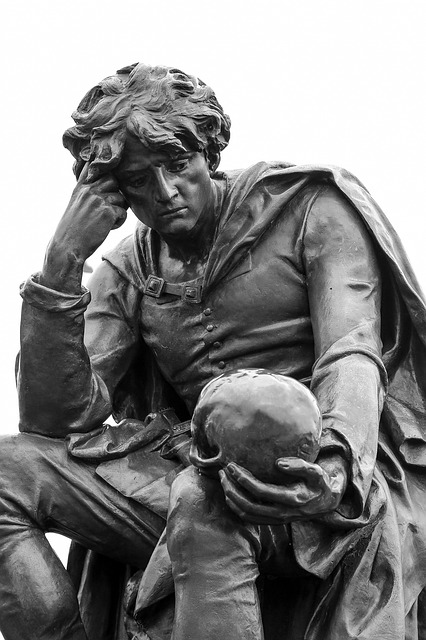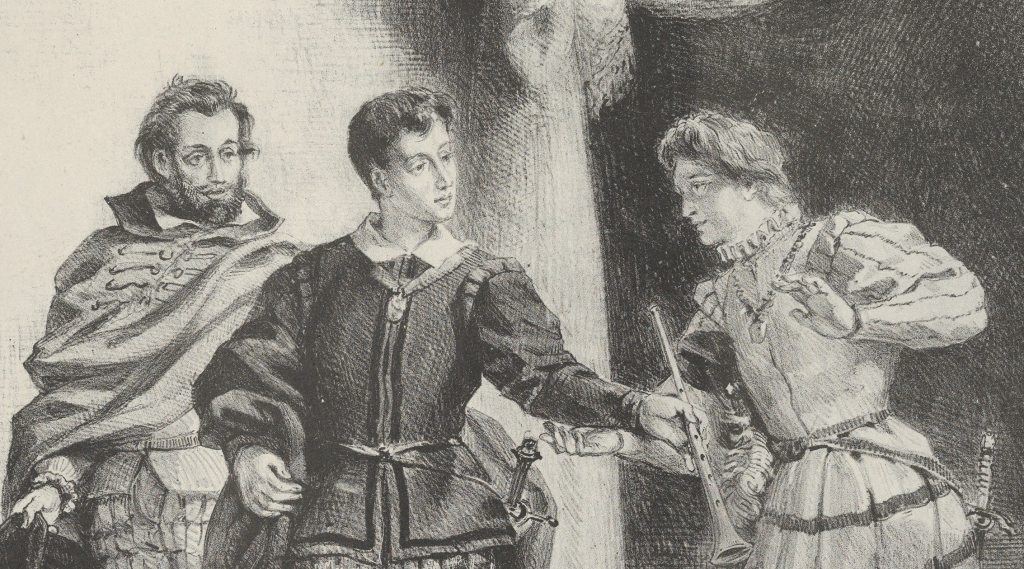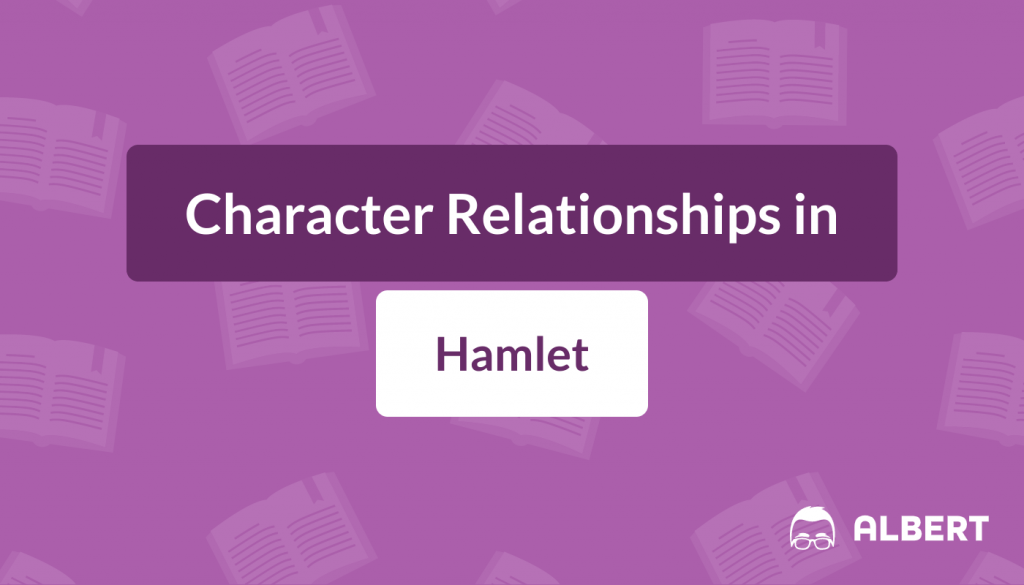The primary characters in Hamlet can be divided into two major groups:
- Hamlet’s family and friends
- Ophelia’s family
The only outlier is Fortinbras, and his tie to the story is his desire to avenge his own father, who Hamlet’s father killed in battle.
However, each of these characters is intimately linked to Hamlet in one way or another, and Hamlet decides fairly quickly who is for him (Horatio), who is against him (Claudius, Gertrude, Polonius, Laertes, Rosencrantz, and Guildenstern), and who is simply in the way (Ophelia).
What We Review
Primary Characters in Hamlet:
Hamlet

Hamlet is the main character of the play. He is the Prince of Denmark, whose father has recently died. His mother has remarried his father’s uncle, and Hamlet begins the play in a mournful state. Hamlet also has a love interest, Ophelia. However, it is unclear whether his affections for Ophelia are true or if he is just using her.
Once his father’s ghost appears to him in secret and reveals the true nature of his death, Hamlet becomes fixed on avenging his father’s death by any means necessary. One such means is to feign “madness” to hide his murderous intentions from his uncle and mother. However, throughout the play, it becomes evident that Hamlet struggles to put action behind his words. He enjoys manipulating and toying with people through the use of his words. Still, when it comes to actually avenging his father by killing his Uncle Claudius, his conscience gets in the way.
As the play progresses, however, Hamlet’s “feigned madness” becomes a reality, especially after seeing Claudius’s guilt on full display during a performance of The Murder of Gozago. His mental illness is evident in his apathy toward his accidental killing of Polonius and his rage following the death of Ophelia. Even though Hamlet feels as if he dies in honor, by the end of the play, he has done his family and kingdom no honor. Fortinbras swoops in and conquers Denmark easily.
Claudius
Hamlet has many choice words for Claudius. As far as his role in the play, Claudius is the late king’s brother who is now married to Hamlet’s mother. Through the ghost of Hamlet’s father, it becomes evident that Claudius is guilty of his brother’s murder.
Claudius’ guilt is especially apparent when Claudius is found praying, asking forgiveness for his sins. However, Claudius is not just a murderer; he is also a manipulator. First, Claudius enlists Hamlet’s best friends, Rosencrantz and Guildenstern, to spy on Hamlet for him.
Eventually, Claudius attempts to use these same friends to deliver Hamlet to his death. When that plan fails, Claudius manipulates the mourning Laertes to avenge his father, Polonius, by killing Hamlet. Claudius is clearly a dangerous enemy of both Hamlet and Denmark.
Gertrude
Gertrude is Hamlet’s mother and the new wife of Hamlet’s uncle. Hamlet is disgusted with his mother for marrying his uncle so quickly after Hamlet’s father’s death. Although Gertrude had no part in the murder of Hamlet’s father, she never questioned his sudden death or gave a second thought about marrying his brother.
In her defense, as a woman, Gertrude likely felt pressure to remarry, especially in a position as queen of Denmark. She cares deeply for Hamlet. Still, her loyalty lies most closely with Claudius, not Hamlet, as she defers to any decision made by Claudius on Hamlet’s behalf.
Ophelia

Ophelia is the naive and innocent daughter of Polonius, the sister of Laertes, and the love interest of Hamlet. She is under the impression that Hamlet loves her and intends to marry her; however, once Hamlet begins his act of “madness,” Ophelia is his first victim.
Ophelia has little to no control over her own life, and her brother and father often attempt to structure her life for her, even to the extent of manipulation. When her father is suddenly murdered by Hamlet and her brother is abroad, Ophelia has no one left to direct her life. Therefore, she feels completely abandoned, hopeless, and lost. Whether she drowned accidentally while in a distracted state or committed suicide, Ophelia is a sad casualty of Hamlet’s path to revenge.
Polonius
As the chief advisor to the king, Polonius has no small view of himself. Polonius takes great pride in his involvement in the affairs of the kingdom and even volunteers himself to do “detective work” when Hamlet seemingly descends into madness.
Hamlet sees Polonius as a pompous joke and enjoys mocking him through confusing dialogue. Polonius decides to spy on Hamlet and ends up murdered when Hamlet mistakes him for his uncle. Polonius is also a father to both Laertes and Ophelia, but his parenting strategy is similar to what we call “helicopter-parenting” today. Not only does he hire someone to spy on his son, but he also uses his daughter to spy on Hamlet and retrieve information for the king.
Laertes
Laertes is the son of Polonius and brother of Ophelia. He sees himself as responsible for his sister’s safety, especially concerning her purity. He is also absent for some major events of the play, including his father’s murder, as he travels abroad in Paris.
When Laertes returns and finds his father dead and his sister incapacitated, Claudius uses his anger to his advantage and convinces Laertes to seek revenge on Hamlet.
Secondary Characters in Hamlet:
Horatio
Horatio is one of Hamlet’s closest friends and his only friend who does not abandon him during the play. Hamlet’s father’s ghost actually appears to Horatio before anyone else, likely because he knew that he had to go through Horatio first to get to Hamlet.
Horatio is the only one in the play who speaks the truth to Hamlet instead of simply telling him what he wants to hear. Hamlet respects Horatio for this, and Horatio is the only one with whom Hamlet is genuine throughout the play. Even upon Hamlet’s death, Horatio is still loyal to Hamlet, and he promises to tell Hamlet’s story.
Rosencrantz & Guildenstern

Rosencrantz and Guildenstern are childhood friends of Hamlet who do not visit Hamlet of their own volition; instead, they are summoned by the king and queen to distract Hamlet from his depressed state. Hamlet recognizes immediately that these two “friends” are merely opportunists, following his uncle’s orders.
Since Hamlet recognizes this so quickly, when the king sends Hamlet with Rosencrantz and Guildenstern along with a note to have Hamlet murdered, Hamlet changes the king’s plan and has his friends killed instead.
Fortinbras
Fortinbras is similar to Hamlet in rank but opposite in nature. He is a prince of Norway who is marching on Denmark. He is also seeking revenge for his father; however, he is calculated in his approach. When he arrives in Denmark by the end of the play, he easily overtakes Denmark since Hamlet has already killed the entire royal family.
The Ghost

The ghost is primarily responsible for setting Hamlet on a path of personal destruction from the start of the play. Even though the ghost cannot physically do anything, he manipulates Hamlet to do exactly what he wants: avenge his death.
Relationships Between Characters in Hamlet
Hamlet does not have a healthy relationship with any of the other characters in the play, as most of his relationships are tainted by dishonesty. Even though Horatio stays true to Hamlet throughout the entire play, Hamlet is not a good friend in return and makes it very difficult for Horatio to stay loyal to him.
Because of rampant dishonesty coming from all sides, both coming from and happening to Hamlet, Hamlet’s steady spiral into madness is not surprising, given that he arrives at a place where he begins to question what is real and what is not. Even though they do not interact with one another during the play, it is interesting to note that Fortinbras is a character foil to Hamlet. Both have lost their fathers and seek revenge; however, Fortinbras is still loyal to his family and authority while Hamlet is not (Tomko).
Increasing Student Understanding of Characters in Hamlet

With so many names to keep track of, we often encourage students to create a map of characters and their relationships in the play by the first Act. Once students understand who is related to whom, they can begin to understand what these characters think of one another and how that influences their words and actions toward that character.
Students should be aware that Hamlet and Fortinbras are foils and track both similarities and differences between the two princes.
Lastly, it is helpful for students to analyze Horatio’s character and put themselves in his shoes. Would you be able to stay loyal to a friend who you saw making poor decisions one right after another?
Use Albert’s Chapter Quizzes to Check for Understanding
Each of our literature courses contains reading quizzes that you can use to track your students’ reading progress and comprehension before moving on to a new section of the text. You can find these reading quizzes in the Assessments tab of our subject guide.
Each act of Hamlet has its own 10 question reading quiz, and each quiz is made up of the following:
| Question Type | Description |
| 5 Multiple Choice Questions | These questions assess students reading comprehension. This way, you can make sure they both read and understand the text! |
| 5 Fill in the Blank Questions | These questions ask students to fill in the blank with the appropriate character or plot point, ensuring that they remember what they have read. |
Conclusion
As with any play, we highly recommend reading this work aloud, assigning roles to various students, and encouraging students to embody these characters’ emotions through their voices as they deliver their lines. A Shakespearean play depends on some action, but it primarily depends on language to convey the story’s emotion.
If students are willing to bring this play to life by showing expression through their voices, these characters and their stories will be that much easier for students to understand.
Works Cited
Shakespeare, William. The Tragedy of Hamlet: with Connections. Holt, Rinehart and Winston, 2000.
Tomko, Seth. “Fortinbras as a Foil for Hamlet.” Owlcation, Owlcation, 22 June 2009, owlcation.com/humanities/Fortinbras-as-a-Foil-for-Hamlet.








